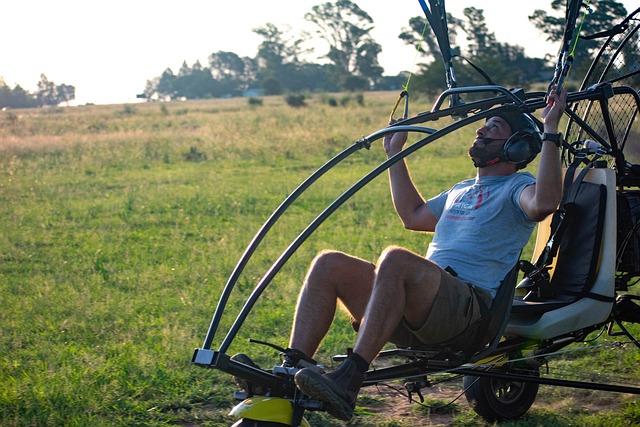Electric paramotors are the latest trend in personal aviation technology, providing a new, eco-friendly way to take to the skies. While traditional gasoline paramotors have been popular for years, electric paramotors are now gaining popularity due to their quiet and smooth operation, cost savings over time, and accessibility for beginners.
In this article, I will provide a comprehensive guide to electric paramotors, covering everything you need to know about how they work, their advantages and disadvantages, how to choose the right one, safety considerations and regulations, and how to get started with electric paramotoring. Whether you’re a seasoned pilot or a beginner looking for a new adventure, this guide will provide the expertise, authority, and trustworthiness you need to navigate the exciting world of electric paramotors.
How Electric Paramotors Work
Electric paramotors use an electric motor to power a propeller, which generates thrust and lifts the pilot into the air. Here’s a breakdown of how electric paramotors work:
Components of an electric paramotor Electric paramotors typically consist of the following components:
- Frame: The structure that supports the motor, battery, and propeller.
- Motor: The electric motor that powers the propeller.
- Battery: The rechargeable battery that provides power to the motor.
- Propeller: The component that generates thrust and lifts the pilot into the air.
- Controller: The device that regulates the power output of the motor and the battery.
- Throttle: The control mechanism that allows the pilot to increase or decrease the speed of the motor.
Battery and motor specifications: The battery and motor specifications of electric paramotors vary depending on the manufacturer and the model. The power output of the motor is measured in watts, and the capacity of the battery is measured in ampere-hours (Ah). Generally, the higher the wattage and Ah, the more powerful and longer-lasting the electric paramotor will be.
Propeller and thrust: The propeller is the component that generates thrust and lifts the pilot into the air. The size and pitch of the propeller can affect the performance and efficiency of the electric paramotor. A larger propeller generates more thrust but requires more power, while a smaller propeller generates less thrust but requires less power.
How electric paramotors differ from traditional gasoline paramotors: Electric paramotors differ from traditional gasoline paramotors in several ways. Electric paramotors are quieter, more eco-friendly, and require less maintenance than gasoline paramotors. However, they have a shorter range, longer charging times, and are generally less powerful than gasoline paramotors.
Advantages of Electric Paramotors
Electric paramotors offer several advantages over traditional gasoline paramotors, including:
- Environmental benefits: Electric paramotors are more environmentally friendly than gasoline paramotors because they produce zero emissions. This makes them ideal for pilots who want to minimize their carbon footprint and enjoy flying without polluting the air.
- Quiet and smooth operation: Electric paramotors operate more quietly and smoothly than gasoline paramotors. This means less noise pollution for the surrounding environment and a more enjoyable flying experience for the pilot.
- Cost savings over time: Electric paramotors can be more cost-effective over time than gasoline paramotors. While the initial cost may be higher, the cost of electricity is generally lower than the cost of gasoline, resulting in lower operating costs. Additionally, electric motors require less maintenance than gasoline engines, which can result in further cost savings.
- Accessibility for beginners: Electric paramotors are often more accessible for beginners than gasoline paramotors. They are easier to operate, require less maintenance, and are generally safer than gasoline paramotors. This makes them an ideal option for new pilots who want to start flying without a steep learning curve.
Overall, electric paramotors provide a more eco-friendly, quiet, cost-effective, and accessible way to experience personal aviation.
Disadvantages of Electric Paramotors
While electric paramotors offer several advantages over traditional gasoline paramotors, they also have some disadvantages to consider, including:
- Limited range: Electric paramotors have a more limited range than gasoline paramotors due to the limitations of current battery technology. Depending on the model and battery capacity, electric paramotors may have a flight time of 30 minutes to an hour before needing to be recharged.
- Longer charging times: Charging an electric paramotor can take several hours, depending on the battery capacity and the type of charger used. This means that pilots need to plan their flights carefully and allow enough time for charging between flights.
- Less power and speed than gasoline paramotors: Electric paramotors are generally less powerful and have lower speeds than gasoline paramotors. This can limit their performance in certain situations, such as flying in strong winds or at high altitudes.
- Higher initial cost: The initial cost of electric paramotors is generally higher than gasoline paramotors due to the cost of the battery and electric motor technology. While this cost may be offset by lower operating costs over time, it can still be a significant barrier to entry for some pilots.
Overall, the limited range, long charging times, lower power and speed, and higher initial cost are important considerations when deciding whether an electric paramotor is a right choice for your personal aviation needs.
Choosing the Right Electric Paramotor
When selecting an electric paramotor, there are several key considerations to keep in mind to ensure you choose the right one for your needs. Here are six key factors to consider:
- Battery life and capacity: The battery life and capacity are important factors to consider when selecting an electric paramotor. Look for a battery with a capacity that will allow you to fly for your desired amount of time, and make sure the battery can be easily removed and replaced.
- Motor power and efficiency: The motor power and efficiency of an electric paramotor will affect its speed, thrust, and performance. Look for a motor with a high power output and efficiency rating for optimal performance.
- Weight and portability: The weight and portability of an electric paramotor are important considerations if you plan to travel with it. Look for a lightweight and compact model that can be easily transported.
- Build quality and durability: The build quality and durability of an electric paramotor will affect its lifespan and maintenance requirements. Look for a model that is built with high-quality materials and has a good reputation for durability.
- Reviews and recommendations: Reading reviews and recommendations from other pilots can be a great way to gauge the quality and performance of an electric paramotor. Look for models with positive reviews and recommendations from experienced pilots.
- Top brands in the market: There are several top brands in the electric paramotor market, including Scout, Nirvana, and Fly Products. Research these brands to determine which one offers the features and performance that meet your needs.
Best Electric Paramotor
There are several top-performing electric paramotors on the market, each with its own unique features and advantages. Here are three of the best electric paramotors, based on their overall performance, quality, and reputation:
- Scout Carbon Fiber Electric Paramotor – The Scout Carbon Fiber electric paramotor is known for its lightweight, compact design, high power output, and a long-range battery. It also features advanced safety features such as an automatic motor shutdown in case of emergency.
- Nirvana Electric Paramotor – The Nirvana electric paramotor is known for its high-quality build, excellent performance, and long battery life. It features a strong and durable frame, a powerful motor, and a high-capacity battery that can provide up to 75 minutes of flight time.
- Fly Products Xenit Electric Paramotor – The Fly Products Xenit electric paramotor is known for its affordability, portability, and ease of use. It features a lightweight and compact design, a powerful motor, and a removable battery that can provide up to 35 minutes of flight time.
Ultimately, the best electric paramotor for you will depend on your individual needs and preferences. It’s important to research and compare different models, read reviews and recommendations, and consider factors such as battery life, motor power, weight, portability, and build quality before making a decision. (Read my article on the top-rated paramotor brands in the market.)
Safety Considerations and Regulations
Safety is a top priority when operating any kind of aircraft, and electric paramotors are no exception. Here are some safety considerations and regulations to keep in mind when operating an electric paramotor:
- Safety gear requirements: When operating an electric paramotor, it’s important to wear appropriate safety gear, including a helmet, eye protection, and sturdy shoes. Additionally, it’s recommended to wear a protective suit to prevent injury in the event of a crash.
- Regulations and certifications for electric paramotors: The regulations and certifications for electric paramotors vary depending on the country and region where you plan to fly. In the United States, for example, electric paramotors are regulated by the Federal Aviation Administration (FAA) and require a pilot’s license to operate. It’s important to research the regulations and certification requirements in your area before operating an electric paramotor.
- Pre-flight and post-flight safety checks: Performing pre-flight and post-flight safety checks is important to ensure the electric paramotor is in good working condition and safe to operate. This includes checking the battery charge, inspecting the motor and propeller for damage, and testing the controls.
- Weather conditions can significantly impact the safety of electric paramotor flights. Avoid flying in high winds, storms, or other hazardous weather conditions. Additionally, be aware of changes in weather conditions during your flight and be prepared to land safely if conditions worsen.
How to Get Started with Electric Paramotoring
Getting started with electric paramotoring can be an exciting and rewarding experience. Here are four steps to take to begin your electric paramotoring journey:
- Training and certification: To operate an electric paramotor safely and legally, it’s important to receive proper training and certification. Look for a reputable flight school or instructor in your area that offers electric paramotor training. They will teach you the skills and knowledge you need to operate the aircraft safely and provide you with the certification required by your local aviation regulatory body.
- Where to fly: When starting out, it’s important to find a suitable location to fly your electric paramotor. Look for an open and unobstructed area with minimal obstacles such as power lines, trees, or buildings. It’s also important to check with local authorities and obtain any necessary permits or permissions before flying.
- Tips for first-time electric paramotor pilots: As a first-time electric paramotor pilot, it’s important to start slowly and gain experience gradually. Take short flights at first and gradually increase your altitude and distance. Always be aware of your surroundings and monitor your battery life to ensure you have enough power to make it back safely. It’s also important to stay within your skill level and avoid taking unnecessary risks.
- Common mistakes to avoid: Common mistakes for first-time electric paramotor pilots include flying in bad weather conditions, taking off or landing on uneven or obstructed terrain, and forgetting to perform pre-flight and post-flight safety checks. Avoid these mistakes by carefully planning your flights, choosing suitable takeoff and landing locations, and following proper safety procedures.
Conclusion
In conclusion, electric paramotors offer an exciting and eco-friendly way to experience personal aviation. While they have some limitations, such as shorter ranges and longer charging times, they also offer several advantages, such as quiet and smooth operation, cost savings over time, and accessibility for beginners.
When choosing an electric paramotor, it’s important to consider factors such as battery life, motor power, weight, portability, and build quality, and to research reviews and recommendations from other pilots. Additionally, safety is a top priority when operating an electric paramotor, and it’s important to follow regulations and safety procedures, receive proper training and certification, and always be aware of your surroundings and weather conditions. By following these considerations and steps, you can begin to enjoy the exhilaration and freedom of electric paramotoring with confidence and safety.








